Canine Malocclusion
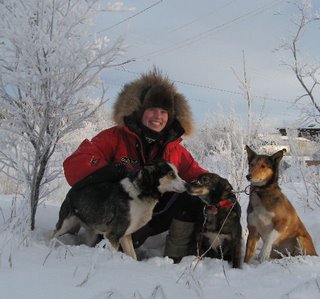
When the nose of Aliy Zirkle’s lead dog Bullet crossed the finish line at this year’s K300, it was only inches ahead of the nose of Paul Gebhardt’s lead dog, Governor. Fortunately for Aliy, Bullet has a particularly long nose; it meant the difference between finishing in the top 10 and not.
.
This photo of Aliy was taken the morning before the race started, with her three leaders of the K300 team, Girlfriend, Donya (my computer doesn’t have an n with a tilde over it), and Bullet. Bullet is the reddish-brown dog on the far right. When you see her head in profile, you can see how looong her nose is.
.
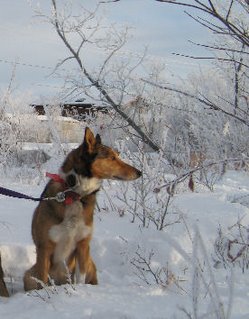 Bullet has canine malocclusion. Her front teeth don’t come together because her lower jaw is too much shorter than her upper dental ridge. She has a terrific overbite. Orthodontic appliances work well to correct the situation in people, but it is a bit more difficult in dogs.
Bullet has canine malocclusion. Her front teeth don’t come together because her lower jaw is too much shorter than her upper dental ridge. She has a terrific overbite. Orthodontic appliances work well to correct the situation in people, but it is a bit more difficult in dogs.
.
The problem with dogs is that their upper and lower canine teeth interlock when their jaws are closed. In the bite impression of a dog with normal jaws, the lower canines fit in front of the upper canines. When those four teeth don’t come together correctly, the lower canines can actually drill holes in the dog’s hard palate. The problem is solved by either grinding the lower canines flat, or extracting them altogether.
.
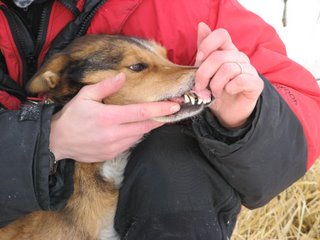 In Bullet’s case, the lower jaw was so short that nothing had to be done; the lower canines are so far back they don’t hit anything. The space where they should fit is easily visible in front of the upper canine. For comparison, our house dog Bear’s bite is completely normal.
In Bullet’s case, the lower jaw was so short that nothing had to be done; the lower canines are so far back they don’t hit anything. The space where they should fit is easily visible in front of the upper canine. For comparison, our house dog Bear’s bite is completely normal.
Anyone can see from looking at her that Bullet’s malocclusion is not a problem for her. She eats well, runs fast, and is a smart leader. And she is very used to having her mouth shown, though she doesn’t quite get why everyone is so interested.
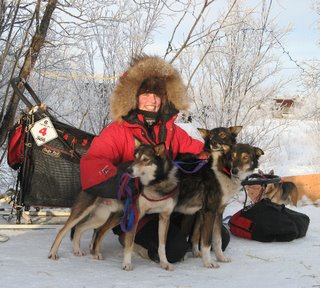 One more photo from the pre-race photo session. These are three more of Aliy's dogs, Nutmeg, Rolo and Snickers. They are two- and three-year olds, and have great racing careers ahead of them. The experience they got running the Kuskokwim 300 will serve them well in future Iditarods.
One more photo from the pre-race photo session. These are three more of Aliy's dogs, Nutmeg, Rolo and Snickers. They are two- and three-year olds, and have great racing careers ahead of them. The experience they got running the Kuskokwim 300 will serve them well in future Iditarods.
My fingers are crossed for Aliy and her husband Allen Moore this weekend; they are both running teams in the Tustumena 200 over in Kenai, Alaska. I'd love to see them take first and second!
Photos by The Tundra PA.
Labels: Dog Mushing
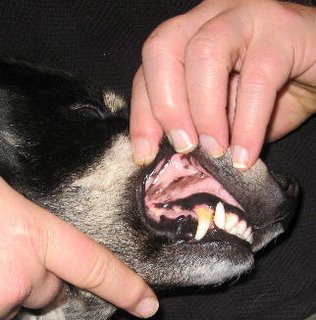




3 Comments:
I want to put in my 2 cents worth-just because we don't comment doesn't mean we aren't interested. I am so busy that I barely have time to read let alone comment. When I read about the dogs there, I think about one of ours, he just wants to run, think I will make him a harness & hook him up to a little wagon....maybe Alaska is where runner dogs dream about when they are sleeping.... they aren't chasing rabbits, they are pulling a sled!
Another race to follow! I think you have me hooked on mushing. Great pics of Ally and her dogs. Thanks for including clickable links to the race results sites. It's surprising to a Lower 48'er how relatively small in stature the dogs are. I had pictured them as large, Malumute types. They must be very strong for their size. How, generally, are their dispositions? I think I recall stories of Arctic Native Americans cautioning theis children against becoming too friendly with the dogs.
CC--thanks for adding your two cents! If you are serious about putting your pet dog in harness, check out Cold Spot Feeds for gear. Skijoring is great fun with one dog.
Cush--Yaaay! I love getting people hooked on mushing. It's such a wonderful sport. Today's racing sled dogs are surprisingly small, usually around 40 lbs each. Smaller dogs are faster and more agile. Back in the days when freight was transported by dog teams, large and strong dogs were needed. That was the heyday for Malamutes, Siberians and other heavily-furred, 80+ lb. dogs. They could pull heavy loads over long distances and required no special pampering (coats, booties) to withstand severe cold. But speed was not the priority then, as it is now. Many sprint mushers are breeding short-haired long-legged hounds with their huskies to get a leggier, faster canine athlete. Even the smaller racing dogs are pretty strong, though. Disposition is very dependant on socializing. When they are handled a lot from early in life, and well treated and well fed, sled dogs are nice and friendly animals. Any competitive musher will see to it that his or her dogs are well socialized and friendly. And that said, we also have a tragic death every couple of years when some unsupervised toddler walks into a dog yard and gets mauled. Village dog teams can be half-wild and half-starved animals and those things happen, but only in remote places. Alaska Native children are taught that sled dogs are working animals, not pets, and they must be wary until they know whether any dog is friendly or not.
Post a Comment
<< Home